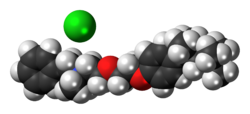 | |
 | |
| Names | |
|---|---|
| Preferred IUPAC name N-Benzyl-N,N-dimethyl-2-{2-[4-(2,4,4-trimethylpentan-2-yl)phenoxy]ethoxy}ethan-1-aminium chloride | |
| Systematic IUPAC name Benzyldimethyl(2-{2-[4-(2,4,4-trimethylpentan-2-yl)phenoxy]ethoxy}ethyl)azanium chloride | |
| Identifiers | |
3D model (JSmol) | |
| 3898548 | |
| ChEBI | |
| ChEMBL | |
| ChemSpider | |
| ECHA InfoCard | 100.004.073 |
| EC Number |
|
| KEGG | |
| MeSH | Benzethonium |
PubChem CID | |
| RTECS number |
|
| UNII | |
| UN number | 2923 |
CompTox Dashboard (EPA) | |
| |
| |
| Properties | |
| C27H42ClNO2 | |
| Molar mass | 448.09 g·mol−1 |
| Melting point | 163 °C (325 °F; 436 K) |
| 40 g dm−3 (at 20 °C) | |
| Pharmacology | |
| D08AJ08 ( WHO ) R02AA09 ( WHO ) | |
| topical | |
| Legal status |
|
| Hazards | |
| GHS labelling: | |
   | |
| Danger | |
| H301, H314, H400 | |
| P273, P280, P305+P351+P338, P310 | |
Except where otherwise noted, data are given for materials in their standard state (at 25 °C [77 °F], 100 kPa). | |
Benzethonium chloride, also known as hyamine, is a synthetic quaternary ammonium salt. This compound is an odorless white solid, soluble in water. It has surfactant, antiseptic, and anti-infective properties and it is used as a topical antimicrobial agent in first aid antiseptics. It is also found in cosmetics and toiletries such as soap, mouthwashes, anti-itch ointments, and antibacterial moist towelettes. Benzethonium chloride is also used in the food industry as a hard surface disinfectant. [1]